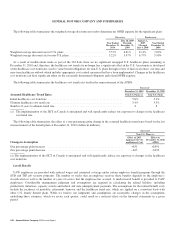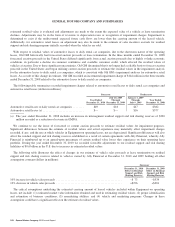General Motors 2010 Annual Report Download - page 103
Download and view the complete annual report
Please find page 103 of the 2010 General Motors annual report below. You can navigate through the pages in the report by either clicking on the pages listed below, or by using the keyword search tool below to find specific information within the annual report.GENERAL MOTORS COMPANY AND SUBSIDIARIES
Deferred Taxes / Valuation Allowances
We establish and Old GM established valuation allowances for deferred tax assets based on a more likely than not standard. The
ability to realize deferred tax assets depends on the ability to generate sufficient taxable income within the carryback or carryforward
periods provided for in the tax law for each applicable tax jurisdiction. We consider and Old GM considered the following possible
sources of taxable income when assessing the realization of deferred tax assets:
• Future reversals of existing taxable temporary differences;
• Future taxable income exclusive of reversing temporary differences and carryforwards;
• Taxable income in prior carryback years; and
• Tax-planning strategies.
The assessment regarding whether a valuation allowance is required or should be adjusted also considers all available positive and
negative evidence factors, including but not limited to:
• Nature, frequency, and severity of recent losses;
• Duration of statutory carryforward periods;
• Historical experience with tax attributes expiring unused; and
• Near- and medium-term financial outlook.
Concluding a valuation allowance is not required is difficult when there is significant negative evidence that is objective and
verifiable, such as cumulative losses in recent years. We utilize and Old GM utilized a rolling three years of actual and current year
anticipated results as the primary measure of cumulative losses in recent years, as adjusted for non-recurring matters.
The valuation of deferred tax assets requires judgment in assessing the likely future tax consequences of events that have been
recognized in our financial statements or tax returns and future profitability. Our accounting for deferred tax consequences represents
our best estimate of those future events. Changes in our current estimates, due to unanticipated events or otherwise, could have a
material impact on our financial condition and results of operations.
Though objective and verifiable negative evidence continues to outweigh positive evidence in our key valuation allowance
jurisdictions, we are experiencing positive evidence trends in various jurisdictions. South Korea and Australia are farther ahead in this
trend of sustained operating profits and taxable income. U.S. and Canada operations are showing early signs of this positive evidence
trend, and Germany, Spain and the United Kingdom operations are not yet experiencing such a favorable shift. To the extent this trend
continues, it is reasonably possible our conclusion regarding the need for full valuation allowances could change, resulting in the
reversal of some or all of the valuation allowances.
Refer to Note 23 to our consolidated financial statements for additional information regarding deferred taxes and valuation
allowances.
Valuation of Vehicle Operating Leases and Lease Residuals
In accounting for vehicle operating leases, a determination is made at the inception of a lease of the estimated realizable value (i.e.,
residual value) of the vehicle at the end of the lease. Residual value represents an estimate of the market value of the vehicle at the end
of the lease term, which typically ranges from nine months to five years. A customer is obligated to make payments during the term of
a lease to the contract residual. A customer is not obligated to purchase a vehicle at the end of a lease, and we are and Old GM was
exposed to a risk of loss to the extent the value of a vehicle is below the residual value estimated at contract inception.
Residual values are initially determined by consulting independently published residual value guides. Realization of residual values
is dependent on the future ability to market vehicles under prevailing market conditions. Over the life of a lease, the adequacy of the
General Motors Company 2010 Annual Report 101
























